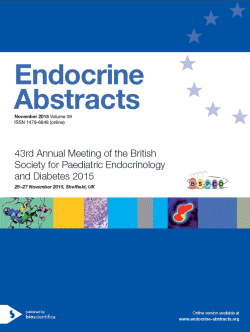
43rd Meeting of the British Society for Paediatric Endocrinology and Diabetes
ORAL COMMUNICATIONS
Oral Communications 5
ea0039oc5.1 | Oral Communications 5 | BSPED2015
Mutations in IGSF10 cause self-limited delayed puberty
Howard Sasha , Guasti Leonardo , Ruiz-Babot Gerard , Mancini Alessandra , David Alessia , Storr Helen , Metherell Louise , Cabrera Claudia , Warren Helen , Barnes Michael , Wehkalampi Karoliina , Gothilf Yoav , Andre Valentina , Cariboni Anna , Dunkel Leo
ea0039oc5.2 | Oral Communications 5 | BSPED2015
Genetic characterisation of children with short stature and GH or IGF1 insensitivity by single gene and whole exome sequencing
Shapiro Lucy , Savage Martin , Metherell Lou , Storr Helen
ea0039oc5.3 | Oral Communications 5 | BSPED2015
Dominant negative STAT5B variants in two families with mild GH insensitivity and eczema
Pease-Gevers Evelien , Klammt Jurgen , Andrew Shayne , Kowalczyk Julia , Metherell Lou , Neumann David , Dattani Mehul , Hwa Vivian
ea0039oc5.4 | Oral Communications 5 | BSPED2015
White matter integrity and neurocognitive deficits in children with hyperinsulinemic hypoglycaemia and ketotic hypoglycaemia: a comparison study
Kumaran Anitha , Bullock Jemima , Seunarine Kiran , Chong Kling , Kapoor Ritika , Vargha-Khadem Fareneh , Clark Chris , Hussain Khalid
ea0039oc5.5 | Oral Communications 5 | BSPED2015
A novel, missense, mutation (P81R) in the TRH receptor gene in congenital central hypothyroidism
Koulouri Olympia , Nicholas Adeline , Schoenmakers Erik , Mokrosinski Jacek , Lane Frances , Cole Trevor , Kirk Jeremy , Farooqi Sadaf , Chatterjee Krishna , Gurnell Mark , Schoenmakers Nadia
ea0039oc5.6 | Oral Communications 5 | BSPED2015
Bone histomorphometry in patients with TMEM38B mutations suggests a novel patho-mechanism leading to increased bone fragility
Webb Emma , Balasubramanian Meena , Fratzl-Zelman N , Titheradge H , Cole Trevor , Stewart S , Crabtree Nicola , Cabral W B , Owens B , Roschger P , Klaushofer K , Marini J C , Shaw N , Hogler W
ea0039oc5.7 | Oral Communications 5 | BSPED2015
Prevalence, management, and long-term outcomes of osteonecrosis in young people with acute lymphoblastic leukaemia
Amin Nadia , Kinsey Sally , Feltbower Richard , Mushtaq Talat , James Beki
ea0039oc5.8 | Oral Communications 5 | BSPED2015
Neonatal TSH: is it useful and appropriate as an indicator of iodine insufficiency in the UK?
Sharif Sahar , Jones Jeremy , Smith Sarah , Combet Emilie
ea0039oc5.9 | Oral Communications 5 | BSPED2015
Assessing aortic dilatation using aortic sized index is inappropriate in children and adolescents with Turner syndrome
Wong S C , Ehtisham S , Cheung M , Zacharin M
ea0039oc5.10 | Oral Communications 5 | BSPED2015
Pegvisomant treatment for X-linked acrogigantism syndrome
Coxson Edward , Iacovazzo Donato , Bunce Benjamin , Jose Sian , Ellard Sian , Sampson Julian , Korbonits Marta , Burren Christine



